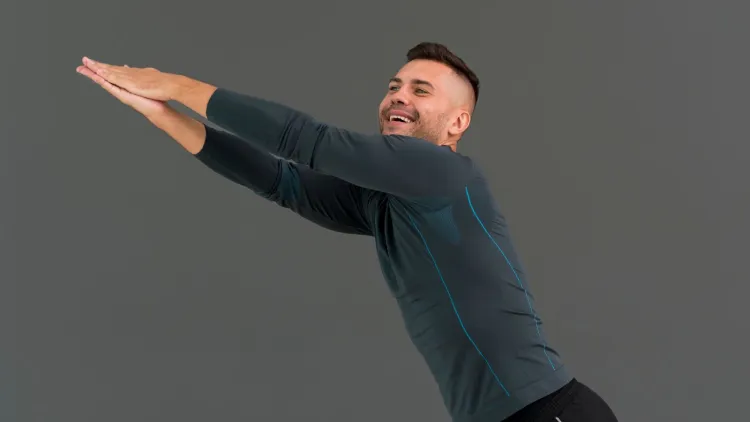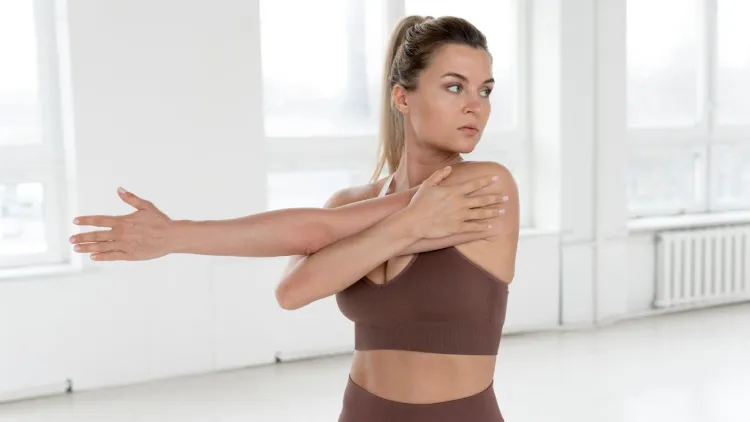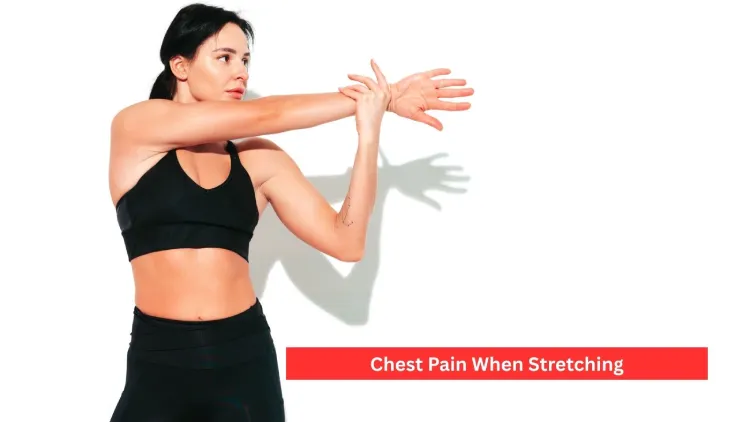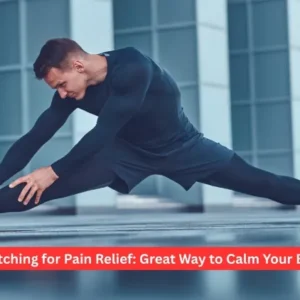Chest pain when stretching is alarming, and most people right away think of the possibility of a heart issue. Although it is important to exclude a possible heart disorder, in most cases, such kind of pain is triggered by not-so-severe yet worrying reasons, such as muscle strain, bad posture, or joint/nerve discomfort. The list of possible reasons that may be causing your pain to move is long and includes the tension caused by anxiety disorders or such illnesses as costochondritis and poor alignment of the ribs, and damaged chest muscles.
This complete guide will take you through the most prevalent causes of chest pain when stretching and the ways of differentiating between muscular and more severe pains, when you should see the emergency and what tips to avoid it. You will also relax with good stretches to get out of the tightest chest and become more flexible, and you will be able to move confidently and safely. Regardless of whether the pain you have is recurrent or chronic, identifying the cause of your pain is going to be the first step in relief and cure. You can view our previous article if you’re concerned about lower back pain.

Common Causes of Chest Pain When Stretching
A number of reasons can cause chest pain when stretching, whether it is a simple muscular problem or a more complicated situation. The most usual reasons are listed below:
1. Muscle Strain
A strain or tear in chest muscles is one of the most common causes of chest pain when stretching, especially the pectoralis major. This may occur when you overstretch, you make a sudden movement or when you lift a heavy weight without form. The pain related to muscle strain is usually localised, sharp, and aggravated once the muscle is moved again. You may even be sore even days after the incident.
This type of muscle strain is particularly common among athletes, those who exercise in the gym and individuals doing manual work. It is vital to distinguish between this kind of pain and the more serious internal pain in the chest, as it could symbolise the existence of a more vital problem.
2. Costochondritis
Costochondritis refers to inflammation in cartilages that bind the rib cage and the sternum (breastbone). It usually causes chest pain when stretching, deep breathing, or coughing. The discomfort is often acute and localised to the front of the chest, and it is possible to recreate the pain by compressing the victim at the site of the attack.
Costochondritis is a result of injury, excessive use or even viruses. It will appear indistinguishable from heart pain, but since it is not life-threatening, it may be hard to recognise unless a doctor examines.
3. Poor Posture
Working or sitting in front of the desk, frequent slouching, or even sleeping in slightly wrong positions causes chest muscles to be tight, and the back muscles to be weak. In the long run, your chest wall is strained by this muscular imbalance and can lead to chest pains on stretching, particularly during movements where one is required to open up the front of the body or twist the torso.
Over time, you can relieve this kind of pain through fixing your posture and engaging in some gentle stretch exercises.
4. Rib Misalignment/Injury
Incidental motions or stretches usually produce a painful sensation when the minor ribs have been dislocated or fractured incorrectly. In case of a recent fall, car accidents, or upper body strikes, you should consider that the cause of the chest pain during stretching could be an injury to one of the ribs.
Although the injury might appear to be minor, the pain might recur or worsen upon deep breathing or movement of the arm. Sometimes it may also be due to inflammation of the tissue around the ribs, thus causing the same symptoms, particularly during chest-opening exercises.
5. Nerve Compression
The second possible explanation of pain in the chest with stretching is the nerve compression of any origin (particularly, primarily the spine or neck). The pain may also go to the chest when the spinal nerves are compressed as a result of disc problems or misalignment of the vertebrae. This may be a burning sensation or a sharp stabbing pain that can also be accompanied by numbness or tingling in the arms or hands.
Some of the strains that cause this pain, backwards backbends or side twists, may be more than the other strains that are caused by muscles or joints, and can indicate that the problem can be in the nerves.
6. Anxiety /Panic Attacks
Although this is not brought about by stretching directly, when you stretch, you may experience anxiety, which may bring about chest pains caused by the effect of anxiety in your body. The stress may cause shallow breathing or tension, which may cause chest discomfort. Individuals with panic attacks normally explain the chest pain as either sharp or tight, and it can increase when they attempt to breathe deeply or extend their upper body.
In case the chest pain is accompanied by stressful moments, feelings of rushing thoughts, or shortness of breath, it can be emotionally related.

Signs It’s Muscular and Not Heart-Related
It may be complicated to realise whether chest pain during stretching is muscular or something more severe. But certain signs tending to indicate a musculoskeletal cause can be listed:
- Localised pain: You can tell which part is painful.
- Made aggravated by movement: when you engage in some motions, such as raising your arms or rotating your torso, the pain gets worse.
- Gets better when resting: It feels better in motionless periods or when stretching.
- Touch: Tenderness with touch or pressing on the associated pain aggravates the pain.
- History of injury or overuse: You just did an exercise, picked up a heavy item, or had trauma to the chest area.
Provided they precede other symptoms and you are otherwise healthy, such signs indicate that the pain is a result of strain or a musculoskeletal problem.
When to Seek Medical Help
The majority of the cases of chest pain during stretching are safe, but there are some times when you should not risk it. Immediately call the doctor following the landing of your chest hurting:
- Sudden and severe
- Spreading to your left arm, neck, jaw or back
- Sweating, or fainting, accompanied by dizziness
- These are accompanied by either nausea or shortness of breath
- Not connected to action or location
These are some signs of a heart attack, pulmonary thrombosis, or another serious illness, which requires immediate attention. When in some sort of doubt, it is always safer to be conservative and undergo an examination by a physician.

Prevention Tips
If you’ve experienced chest pain when stretching before or want to avoid it altogether, here are some practical steps to help prevent it:
1. Warm Up the Proper Way
Make sure that your body is warmed up before stretching or taking part in a sport where you intend to do intense physical activities. This allows more blood to flow to your muscles, thereby making them less tensed and liable to harm.
2. Exercise Good Posture
Sitting, standing, as well as sleeping in good posture avoids any unwarranted pressure on the chest and back muscles. The tightness and the subsequent chest pain on stretching may be caused by poor posture.
3. Stretch Gradually
Never put your body into a stretch. Start it gradually and go into each position 15-30 seconds at a time. The excessive extension may result in the tearing and irritation of the muscles, especially those found in the chest area.
4. Build Supporting Muscles
Strengthening your lower back and shoulder muscles and your abdominal muscles enables them to support some of the pressure put on your chest, which minimises the possibility of strain when stretching or exercising.
5. Drink Lots of Water and Sleep Well
You get a higher chance of having muscle cramps and tightness due a dehydration or tiredness. Drinking enough water and getting a good night’s sleep aids the ability to keep your muscles working and recovering.
6. Breathe Correctly
When you are stretching, holding your breath may create excess tension in your chest muscles. Deep, buffered breathing will enhance the flow of oxygen as well as relax your muscles.
Best Stretches to Relieve Chest Tightness
In case your chest pain when stretching is due to tight muscles or poor posture, then the following gentle exercises will help:
1. Doorway Stretch
Lean against a doorway, and have your arms on both sides of the doorway in line with your shoulders. Take one step forward and lean over into the doorway until you feel a stretch in your chest. Breathe and hold 20 to 30 seconds.
2. Wall Chest stretch
Put one hand on a wall turned on the palm. Turn slowly your body aside the wall, but keep your arm straight. This stressor uses the chest and shoulders. Construct and repeat the other side.
3. Chakrasana side Stretch Child Pose
Start in a kneeling position with your arms straight out in front of you and walk your hands aside, sitting in a low squat. The chest, back and side body are worked in this stretch.
4. Chest-Foam Rollers
Sit on a foam roll, which should be vertical on your backbone. Drop the arms to the respective sides with palms towards the sky. This passive stretch opens the chest and removes the stress in the tight muscles.
When these stretches are carried out on a regular basis, they can enhance flexibility and body posture and limit the recurrence of chest pain in the future.

Final Thoughts
Chest pain when stretching can be considered a cause of concern, but in reality, the condition has nothing to do with heart-related problems, as it is more likely to be referred to as muscle strain or postural troubles or joint problems. With the knowledge of the most frequent causes and the usage of preventive measures, you are able to control discomfort and limit it.
Nevertheless, in case the pain is persistent, severe, or other symptoms, such as shortness of breath, occur, consult a professional doctor at all times. The priority should be yours, health and safety.
Frequently Asked Questions
1. Is the heart related to pain in the chest during stretching?
Not necessarily. Although it is important not to eliminate heart causes, the cause of chest pain during stretching is mainly muscle strain or bad posture, costochondritis, or nerve compression. When the pain is acute, directional and gets worse when a person moves, it is more likely to become muscular. Nevertheless, when it comes with other symptoms such as shortness of breath, radiating pain or dizziness, seek medical care immediately.
2. I stretch, and I do not know how to know the difference between muscular or serious chest pains?
Muscle pains tend to be focal, with certain movements worsening the pain and rest alleviating the condition. It can also be soft to the touch. Chest pain associated with other severe problems, such as heart conditions, on the other hand, tends to be diffuse, which means it may spread to other parts (arm or jaw), and could be accompanied by nausea, sweating, fainting, etc. Seek advice from a medical practitioner in case of uncertainty.
3. Which stretches can be used to stretch tight muscles causing pain in the chest?
A doorway stretch, wall chest stretch, child pose side stretch, and foam roll chest opener are subtle stretches that can be used to stretch the tight muscles on the chest and enable better postures. They should be done with deep breathing and slowly. Do not overstretch, and cease at once in case of increased pain.
4. What can I do to avoid chest pain during stretching in future?
In order to avoid developing chest pain during chest stretching, one should warm up before stretching, use good posture, develop core and back strength, hydrate and breathe properly during exercises. Do not make sudden and drastic movements that strain the muscles. Your chest muscles can also be kept in shape through regular stretching and body mobility exercises.







